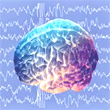Monday, 16 September 2013
Brain Rhythms: The Oscillations That Bind

Most of the neurons in the human brain emit nerve impulses (also known as action potentials) at a specific frequency, which may vary from just a few per second to several hundred per second. The chaotic brain activity revealed by an electroencephalogram (EEG) reflects the summing of all these oscillations in the billions of neurons in the brain.
Not so long ago in the history of neuroscience, the chaotic nature of all these oscillations caused them to be regarded as background noise and given little attention, or even dismissed as an epiphenomenon of no importance. But times have changed. The temporal dimension of brain activity, as expressed by these brain rhythms, is now central to neuroscientific research on complex topics such as sleep and consciousness.
In this week’s post, we’re sharing links to lengthy, fascinating interviews with two pioneers in this area of neuroscientific research. The first, Rodolfo Llinás, has done a great deal of work on the role of the neuronal rhythms that are observed in the communications between the thalamus and the cortex through which consciousness emerges. At one point in the interview he describes the importance of neuronal oscillations for synchronizing the various properties that we perceive in an object—properties such as size, color, and movement, which often activate distinct groups of neurons far from one another in the brain. By firing together at a certain rhythm, these groups of neurons are able to recognize one another and solve what is known as the binding problem.
In the second interview, neuroscientist György Buzsáki reminds us that cyclical phenomena such as neuronal oscillations are present throughout nature. All that has to happen is for two forces to oppose each other, and a flat calm will quickly be replaced by a rhythm. And the brain is full of opposing forces. One good example is the way that sodium ions and potassium ions, by passing through the cell membrane in opposite directions, generate action potentials. Another is the way that inhibitory neurons inserted among excitatory neurons can punctuate their stream of nerve impulses with silences, thus creating a rhythmic phenomenon.
This is a very economical way for the brain to encourage the synchronization of neuronal activity—a phenomenon that, as Buzsáki reminds us, is of great importance for many complex cognitive processes, such as memory. Because when two populations of neurons are oscillating at the same rhythm, it becomes much easier for them to synchronize large numbers of nerve impulses by simply bringing their oscillations into phase. As a result, entire neuronal assemblies then recognize and begin talking to one another, and a conscious perception may then emerge.
![]() The Electric Brain: an interview with neuroscientist Rodolfo Llinás
The Electric Brain: an interview with neuroscientist Rodolfo Llinás
![]() Brain Science Podcast #31: Brain Rhythms with György Buzsáki
Brain Science Podcast #31: Brain Rhythms with György Buzsáki
![]() Transcript of Brain Science Podcast #31, an interview of György Buzsáki
Transcript of Brain Science Podcast #31, an interview of György Buzsáki
about his book, Rhythms of the Brain
The Emergence of Consciousness | Comments Closed







